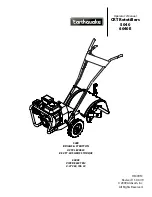
Form 824262
Page Number - 21
CLOSED position towards BYPASS (Fig. 31). Adjust the valve until the flowmeter
indicates an amount of fuel flow equivalent to the value for the maximum engine fuel
volume taken from the table (Fig. 32).
10. Note the pressure reading on the gauge.
11. After noting the peak demand pressure, return the flow control valve to the OPEN posi-
tion. Testing is complete.
Diagnosing the Results
The values for four critical fuel system performance indicators should have been noted
while following the procedures and performing the tests outlined above:
• Idle
Pressure
•
Peak Demand Pressure
•
Peak (Dead-head) Pressure
•
Peak (Bypass) Flow
These indicators are the key to properly diagnosing a malfunctioning fuel delivery system,
and pinpointing the cause.
Compare the four values to the Returnless (electronically regulated) Fuel System Diagnos-
tic Chart (Appendix D). If according to the chart, the FST test values indicate a normal oper-
ating fuel delivery system, then the engine is receiving the proper pressure and flow of fuel,
even under maximum load conditions. If the FST indicates a normal operating fuel delivery
system, yet the vehicle continues to experience symptoms of a fuel delivery malfunction, it
could be caused by
contaminated fuel, faulty fuel injector(s) or electronic control system, or an intermittent com-
ponent malfunction such as a loose electrical connection.
If the FST test results indicate a fuel delivery system malfunction,
and the diagnostic chart clearly pinpoints the cause, follow the vehicle manufacturer’s repair
procedures to correct the malfunction. After performing the repairs, re-test the fuel delivery
system with the FST
to ensure it is operating normally.
If the FST test results are inconclusive as to whether there is a fuel delivery system mal-
function, or if a malfunction is evident but the diagnostic chart does not clearly indicate the
cause, additional testing may be performed to provide more insight into the performance
of the system. Extended test procedures are outlined below, and provide a more in-depth
understanding of how the components of the fuel
system affect its performance.
Additional Testing and Diagnostics
Blocked Inline Fuel Filter
If the vehicle has an accessible fuel filter, and initial test results
indicate it may be partially blocked, retest the fuel system with the FST connected between
the fuel tank and the filter, preferably at the filter inlet. If the peak flow and peak demand
pressure are higher than in the initial test, replace the fuel filter and retest. If the peak flow
and peak demand pressure remain the same, this would indicate a clogged inlet strainer/
sock.
Clogged Inlet Strainer/Sock
The test results for pressure and flow of a clogged inlet strainer will closely match those of a
clogged inline filter. The peak demand
pressure of a clogged inlet strainer will be slightly lower than that
of a clogged inline filter, and the current draw will also be lower.
A clogged inlet strainer can cause the fuel pump to cavitate because it is starved for fuel.
Cavitation will create rapid changes in fuel
density, causing the float in the FST flowmeter to bounce up and down during the peak flow
and/or peak demand test. It can also cause the needle on the pressure gauge to bounce. In
addition,
as the pump tries to pull fuel through the clogged strainer, it creates
a pressure drop that may cause air bubbles to form and become
visible.












































